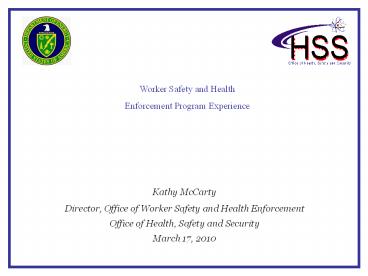Worker Safety and Health Enforcement Program Experience - PowerPoint PPT Presentation
1 / 25
Title:
Worker Safety and Health Enforcement Program Experience
Description:
Worker Safety and Health Enforcement Program Experience Kathy McCarty Director, Office of Worker Safety and Health Enforcement Office of Health, Safety and Security – PowerPoint PPT presentation
Number of Views:60
Avg rating:3.0/5.0
Title: Worker Safety and Health Enforcement Program Experience
1
Worker Safety and Health Enforcement Program
Experience
Kathy McCarty Director, Office of Worker Safety
and Health Enforcement Office of Health, Safety
and Security March 17, 2010
2
Actions Completed (since last conference)
SLAC Notices of Violation - PVC pipe explosion
- Stanford University and two subcontractors
ANL Notice of Violation - arsenic ampoule
explosion - carbon monoxide overexposure
BNL Consent Order - well house explosion
3
Actions Completed (since last conference)
Enforcement Letters - Parsons (SRS) Form Wood
Timber Fire - CWI (Idaho) Electrical Safety
Deficiencies
4
Ongoing Cases
- LLNL Beryllium Program Deficiencies
- SNL Sled Track Accident
- ETTP Electrical Arc Event
- LANL Electrical Shock Event
- WCH Catwalk Fall
- SRNS Nitric Acid Spill and Electrical Arc Event
- - Parsons (SRS) Crane Lubrication Hand Injury
5
Arsenic Ampoule Explosion
- Principal Investigator attempting to synthesize a
new material described in an as yet unpublished
journal article - Two small sealed quartz ampoules containing
elemental arsenic and iron, and a lanthanum
compound heated in a muffle furnace - Ampoules fail catastrophically
6
Arsenic Ampoule Explosion
- Smoke alarm activates and building evacuated
- One evacuee notes a white haze in laboratory
- Laboratory was unoccupied no injuries
7
(No Transcript)
8
(No Transcript)
9
(No Transcript)
10
(No Transcript)
11
(No Transcript)
12
(No Transcript)
13
Problems Identified
- Did not have an approved Experiment Safety Review
- Did not identify use of carcinogens in laboratory
- Did not identify pressure hazard associated with
heating arsenic above its sublimation temperature - Did not operate the muffle furnace in a fume hood
as required by procedures - Principal Investigator was not trained on
carcinogen health hazards and control measures
14
Carbon Monoxide Exposure
- Glove bag containing CO is used to manipulate
samples housed in a Scanning Tunneling Microscope
holder - CO is needed to maintain the sample in the proper
chemical state - Glove bag used in a continuously vented fume hood
- Glove bag was only partially sealed during
inflation with CO - Glove bag is opened and pressure applied with
hands for deflation
15
Carbon Monoxide Exposure
- Postdoctoral researcher conducting experiment for
the first time using CO experiences symptoms of
CO overexposure - Transported to local hospital
- Carboxyhemoglobin level measured three times the
ACGIH BEI after two hours of oxygen
administration
16
Experimental Steps
1. Open deflated glove bag
Fume Hood
2. STM Parts inside
3. Sealing the glove bag
4. Inflating with CO
5. Assembling STM Box
6. Seal removal
STM Box
7. Deflating Glove Bag
CO- sensor
CO
Glove Bag
8. Removing STM Box
17
(No Transcript)
18
Wide-Mouth Canister
19
Problems Identified
- Did not have an approved Experiment Safety
Review work conducted using an unapproved draft
procedure - Potential for worker exposure to CO was not
assessed prior to experiments workplace
monitoring not conducted - Appropriate hazard controls for use of a
flammable gas and asphyxiant were not identified - Inappropriate CO monitors used
20
Problems Identified
- Fume hood was not evaluated
- Fume hood had no flow monitor or low flow alarm
- Researcher was not effectively trained on hazard
controls for asphyxiants
21
Problems Common to Both Events
- Division ESH Coordinator was not trained and
qualified to manage the divisions safety program
- Division did not implement corporate experiment
safety review process requirements - Division Chemical Hygiene Plan was not updated to
reflect laboratory hazards
22
Notice of Violation
- Four Severity Level I violations
- Noncompliances were not reported into the DOE
Noncompliance Tracking System in a timely manner - No mitigation provided due to weaknesses in event
investigations, time required to fully develop
corrective actions, and failure to correct prior
deficiencies in the divisions experiment safety
review process - Civil Penalty of 280,000
23
Citations
- Hazard identification and assessment (851.21)
- Hazard prevention and abatement (851.22)
- Training and information (851.25)
- General requirements, procedural adherence
(851.10) - 29 CFR 1910.1450(b), (e), and (f) NFPA 45
24
Worker Safety and Health Enforcement Reforms
- Rapid response to safety significant events
- Focus on contractors ability to identify
applicable regulatory requirements and
noncompliances - Emphasize noncompliances with OSHA requirements
25
Resources
- Office of Enforcement Web Page
- http//www.hss.energy.gov/Enforce/
- Enforcement Process Overview
- http//www.hss.energy.gov/enforce/Final_EPO_J
une_2009_v4.pdf































